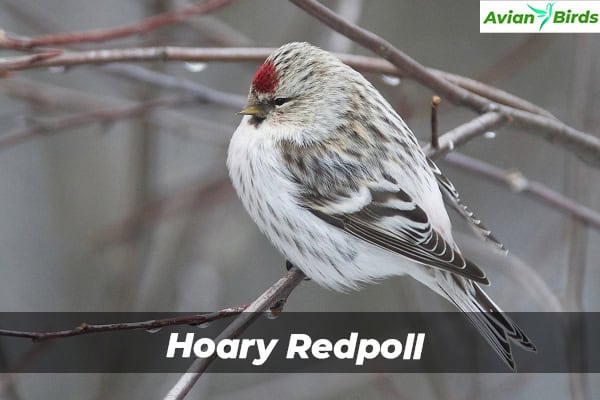Finches In Michigan (10 Species With Pictures)
Are you curious to learn about the finches of Michigan? From the iconic American Goldfinch to the elusive Hoary Redpoll, Michigan is home to an impressive variety of these small, seed-eating birds. Let’s dive into the captivating features and fascinating behaviors of Michigan’s finch residents. Get ready for an avian adventure as we explore the 10 finch species that call Michigan home.
~Learn About 10 Beautiful Species Of Finches Found In Michigan~
Michigan is a great place for birdwatchers, with 10 finch species to see. These birds are colorful and interesting, showing off their unique looks and ways. From the bright American Goldfinch to the Evening Grosbeak, they make birdwatching exciting.
1. American Goldfinch
- Scientific name – Spinus tristis
- Lifespan – 10 years (oldest recorded)
- Size – 4.7 inches
- Weight – 0.5 oz
- Wingspan – 8 inches
The American goldfinch is a year-round bird in Michigan, known as the state bird. It’s a common finch in backyards across the state. With their bright yellow feathers and black cap, wings, and tail, they brighten up parks and backyards.

During the breeding season, males show off their golden feathers. Outside of breeding, they turn brown and gray. Females stay yellow all year. These birds love seeds and can be seen eating on the ground or from feeders.
American goldfinches are a joy in Michigan, loved by birdwatchers and everyone. They add color and energy to our days. Seeing them at feeders or in nature always makes us smile.
2. Common Redpoll
- Scientific name – Acanthis flammea
- Lifespan – 10 years
- Size – 5 inches
- Weight – 0.5 oz
- Wingspan – 8 inches
The common redpoll is a small, compact finch species found in Michigan during winter. They have brown, streaked backs and white underparts with a red cap. These birds visit Michigan in large numbers when food is scarce in their northern homes. They often visit backyard feeders and live in open, weedy areas and forests.

These birds are great at getting seeds from cones and other plants. Their chattering calls let everyone know they’re around. Telling common redpolls apart from similar hoary redpolls can be hard. But, their darker color and more streaks make them stand out.
In Michigan, you can find these finches in weedy fields and by brushlands. In big years, many of these colorful birds come to local trees and feeders. Watching for winter finches is exciting, and the 2023 forecast says Michigan might see common redpolls, purple finches, and pine siskins.
3. Evening Grosbeak
- Scientific name – Hesperiphona vespertina
- Lifespan – 16 years (oldest recorded)
- Size – 6.7 inches
- Weight – 2 oz
- Wingspan – 13 inches
The evening grosbeak is a stunning finch species in Michigan. Males have bright yellow underparts, black wings and tails, and a big, thick bill. Females and young birds have gray and yellow feathers.

Striking Beauty of the Evening Grosbeak
The evening grosbeak’s beauty draws birders to Michigan. They’re known for their loud “chep” or “cheeeep” calls. Their big bills are great for cracking open seeds, especially sunflower seeds.
Breeding and Wintering Range
Evening grosbeaks live in northern Michigan all year. Their numbers in southern Michigan change from year to year. They like coniferous forests and visit backyard feeders for sunflower seeds.
The best places to see evening grosbeaks in Michigan are in the northern half. Look for them in mature boreal forests.
4. Hoary Redpoll
- Scientific name – Acanthis hornemanni
- Lifespan – 6 years
- Size – 5 inches
- Weight – 0.4-0.7 oz
- Wingspan – 0.5 inches
The Hoary Redpoll is a rare finch in Michigan, with only about 1,000 sightings on eBird. It looks frosty and is closely related to the Common Redpoll. You might see them together in the same group. Hoary Redpolls have paler feathers and less streaking under their bodies than Common Redpolls.

Hoary Redpolls visit Michigan in the winter, but their numbers change each year. Spotting them can be hard, even for birding experts. They live in the same places as Common Redpolls, like weedy fields, open woods, and feeders in backyards.
To tell Hoary and Common Redpolls apart, look at their beaks and feathers. Hoary Redpolls have smaller, more delicate beaks and look whiter and less streaked. Their feathers seem like drifting snow, giving them a frosty look. While Common Redpolls are common in Michigan, Hoary Redpolls are rare and exciting to see for birdwatchers.
5. House Finch
- Scientific name – Haemorhous mexicanus
- Lifespan – 11 years (oldest recorded)
- Size – 5 inches
- Weight – 0.8 oz
- Wingspan – 9 inches
The house finch is the second most common finch in Michigan, after the American Goldfinch. They are seen all over the state, but less in the Upper Peninsula. Females have brown and gray feathers.

Abundance and Adaptability
House finches love living in places with people, like parks and suburbs. They visit bird feeders often, making them a common sight. They can be told apart from purple finches by their bright red color and sleek look.
Identification and Habitats
House finches live in Michigan all year, but not as much in the far north. They do well in cities and suburbs, so you might see them in parks and gardens. Look for them at your bird feeders to enjoy their bright colors and lively behavior.
6. Pine Grosbeak
- Scientific name – Pinicola enucleator
- Lifespan – 9 years (oldest recorded)
- Size – 7.9-9.8 inches
- Weight – 2 oz
- Wingspan – 13.0 inches
The pine grosbeak is the biggest finch in Michigan. It has a large, rounded body and a small-looking bill. The male is rosy-red, while the female is gray and orange. These finches are rare in Michigan, mostly found in the north during winter.

They prefer areas with fruiting trees like orchards, parks, and homes with crabapple or cherry trees. You might see them at backyard feeders eating sunflower seeds. Birders in southern Michigan might need to go north to see these finches.
To see a pine grosbeak in Michigan, look for its big, heavy chest and listen to its high-pitched song. With patience and luck, you might see this beautiful bird at your feeder or in a nearby tree.
7. Pine Siskin
- Scientific name – Spinus pinus
- Lifespan – 8 years (oldest recorded)
- Size – 5 inches
- Weight – 0.5 oz
- Wingspan – 8 inches
The pine siskin is a common finch in Michigan, especially in the northern forests. They breed there and use their sharp bills to get seeds from pine cones and other seed heads. In Michigan, most pine siskins breed in the north. But, a few pairs also breed in the south.

Irruptive Winter Visitors Statewide
In winter, pine siskins move all over Michigan looking for food. They can be seen in backyards, cemeteries, and areas with tall trees. The number of pine siskins in Michigan changes a lot from year to year. Sometimes, many of these finches come to the state in the winter.
Boreal Forest Breeders in Northern Michigan
Pine siskins are smaller than American Goldfinches and look like small songbirds. They like to be in groups and make a lot of noise by tweeting. These birds prefer forests with evergreen and deciduous trees. They can be seen flying or showing off their yellow colors when they mate.
8. Purple Finch
- Scientific name – Haemorhous purpureus
- Lifespan – 14 years (oldest recorded)
- Size – 5.5 inches
- Weight – 0.8 oz
- Wingspan – 9 inches
In Michigan, the purple finch is a common sight, especially in the north. They are often mixed up with the house finch. These finches live mainly in the northern part of the state during breeding season. But, they move all over Michigan in winter.

They love areas with juniper trees and shrubs. Here, they eat berries and find shelter from the cold.
Their unique call sounds like a click, which helps birders tell them apart from house finches. Males have a pink-red head and breast, with brown on the back and white on the belly. Females lack the red and have streaks below, along with a whitish eyestripe and dark throat line.
Birdwatchers in Michigan should look out for these beautiful finches. They like to visit feeders and areas with lots of plants. The best time to see them is in winter when they come to backyard feeders.
9. Red Crossbill
- Scientific name – Loxia curvirostra
- Lifespan – 8 years (oldest recorded)
- Size – 7.5 inches
- Weight – 1.5 oz
- Wingspan – 11 inches
The red crossbill is a unique finch found in Michigan, known for its special bill. This bill helps it get seeds from pine and spruce cones. These birds are not often seen at bird feeders because their bills don’t fit typical seeds.

Where to Find These Cone-Feeding Finches
Bird lovers should look for red crossbills in Michigan’s mature coniferous forests. They breed mostly in the Upper Peninsula. In winter, they can be seen in various places with coniferous trees, like cemeteries and neighborhoods.
Identifying red crossbills can be tricky because there are different types. Each type has a unique call and bill shape, suited for certain cones. Recording their call can help identify them. Red crossbills are exciting to spot, especially in winter when they visit different places.
Best Time and Places to Spot Finches in Michigan
Winter is the best time to see finches in Michigan. They come from Canada looking for food. Places like Whitefish Point Bird Observatory and Seney National Wildlife Refuge are great for spotting them. Finches also visit backyard feeders and cities during the cold months.
Wrapping Up…
Michigan is a great place for finches, with 10 different kinds you can find. These finches in Michigan include the American Goldfinch and the Common Redpoll. They come in various colors and sizes, making them fun to watch for birders.
Some finches live in Michigan all year, while others visit or migrate. Their numbers change from year to year. This makes them interesting to study and watch.
The best time to see finches in Michigan is during winter. They come south looking for food. Places like the Whitefish Point Bird Observatory and the Seney National Wildlife Refuge are great spots to see them. Even your backyard feeder can attract finches throughout the year.
Michigan is home to over 460 bird species, making it a top spot for birdwatchers. Finches are especially popular because of their bright colors and unique ways. They are a great challenge and reward for birders of all levels. Michigan’s finches will surely capture your heart and deepen your love for nature.
Thanks for reading!! 🥰🥰🥰 For More Info About Birds Visit Our Avianbirds.com







